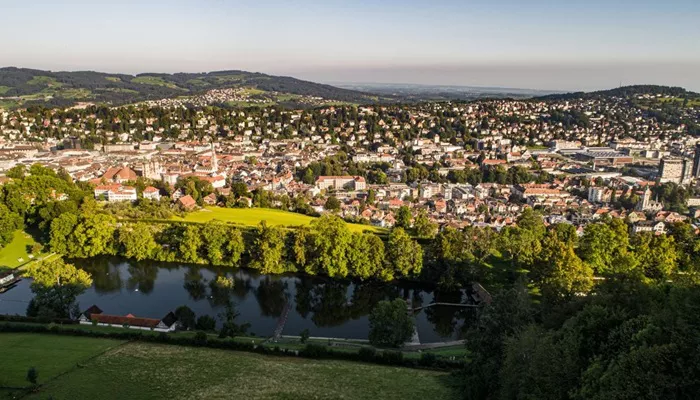St. Gallen, Switzerland, a city known for its rich history in embroidery, is a surprising hub in the global fashion industry. Despite its quaint, fairy-tale appearance—complete with Tudor-style buildings, cobblestone streets, and a grand 18th-century cathedral—St. Gallen’s role in textile production is a deep-rooted one. As my tour guide Ursula pointed out, the city’s history is woven into its very architecture. “You can learn a lot about the textile industry here just by looking at the buildings,” she says. At first, I didn’t quite understand, but by the end of my visit, it became clear how much the past influences the present.
Coming from the high-paced world of Paris Fashion Week, where the latest collections are shown in a flurry of glamor, St. Gallen’s quiet, reflective atmosphere feels worlds apart. Yet, this small Swiss city has shaped the designs of some of fashion’s biggest names.
St. Gallen’s Historical Role in Embroidery
St. Gallen’s textile heritage dates back to the 13th century. The city pioneered a unique form of embroidery known as “chemical lace,” where paper designs are dissolved to reveal intricate lace patterns. While the city’s textile industry suffered after two World Wars and technical advancements, St. Gallen’s embroidery remains a prestigious part of fashion. This craftsmanship can be seen on runways from Dior to Balenciaga and has been worn by figures like Michelle Obama and Amal Clooney.
Ursula showed me how deeply this craft is embedded in the city’s identity. The architecture tells the story of St. Gallen’s textile wealth—from the bay windows that once adorned the homes of linen merchants to the golden heads representing textile trade during the 1800s. Even my hotel, The Einstein, was once an embroidery factory.
At the Textile Museum, I learned more about the women behind this labor-intensive work. Though embroidery is often considered “women’s work,” the skillful hands of St. Gallen’s seamstresses have played a vital role in the city’s economy, particularly during the turmoil of the 20th century. The museum houses thousands of historical lace examples, offering a glimpse into the lives of these workers who, for generations, kept this tradition alive.
A Magnet for Designers
Today, St. Gallen’s embroidery continues to inspire top designers. Forster Rohner, one of the city’s leading textile producers, is a prime example. Inside their headquarters, I found coffee tables stacked with books showcasing runway collections from Valentino, Marc Jacobs, and Balenciaga—collections that all feature St. Gallen-made embroidery.
The company’s archives, dating back to 1883, offer a treasure trove of inspiration for visiting designers. From velvet floral patterns to feather-like stitches, Forster Rohner’s work demonstrates the versatility of St. Gallen embroidery. Designers from all over the world, including brands like Dior, Prada, and Balenciaga, regularly turn to St. Gallen’s artisans for their intricate, high-quality fabric designs.
Luisa, my guide at Forster Rohner, explained that the city’s long-standing tradition of producing these exquisite textiles has earned it the nickname “the mecca of embroidery.” She attributes this reputation to the city’s unwavering commitment to craftsmanship, passed down through generations.
A Slow and Detailed Craft
What sets St. Gallen apart in the fast-paced fashion world is the time and care that goes into its embroidery. Unlike the high-speed production often seen in major fashion capitals, St. Gallen’s artisans focus on the finer details. Forster Rohner’s workshop, where designs are created by hand before being transferred to embroidery machines, is a testament to the painstaking process involved. It can take days for a single design to be completed.
This slower pace is a reflection of the city’s commitment to craftsmanship and quality. In a world of mass production, St. Gallen’s artisans hold on to a time-honored method of creation, where each stitch is carefully crafted.
Embroidery Beyond the Runway
After a designer’s collection is completed, there’s often leftover embroidery, which can be purchased at Forster Rohner’s outlet. These remnants from past runway shows, like Valentino or Burberry, are repurposed into new creations, offering a second life to the exquisite fabric.
During my visit, the buzz surrounding the upcoming Victoria’s Secret fashion show reminded me how relevant St. Gallen’s embroidery still is. The brand enlisted Forster Rohner to help craft the intricate details for their collection, continuing the tradition of hand-sewn, delicate work.
Finding Inspiration in the Details
As my visit came to a close, I found myself reflecting on the small details that make St. Gallen’s embroidery so special. From the dramatic arches of the cathedral to the elegant scalloped edges of a shirt collar, the city has a way of encouraging curiosity and appreciation for the finer things. St. Gallen’s influence on fashion is subtle yet profound, like the intricate designs it produces.
Before catching my train, I revisited the cathedral, this time lingering in the silence, taking in the ornate ceiling and crown moldings. I realized that in a place like St. Gallen, where art, craftsmanship, and history intertwine, the boundary between inspiration and fashion seems almost nonexistent.
Related topics:
- Pope John Graduate Rossi’s Inaugural Fashion Show for New Event-Planning Group a Resounding Success
- These Puffer Jackets Are Bold Fashion Statements You Can’t Miss
- Jennifer Lopez’s Bold Pantsless Look Shows This Fall Trend Has No Limits

